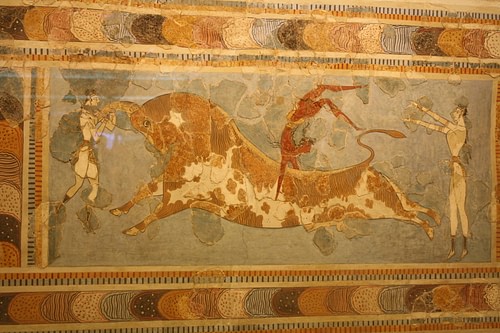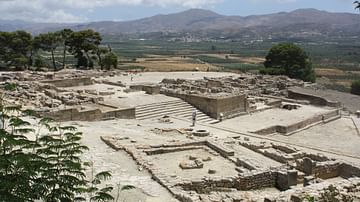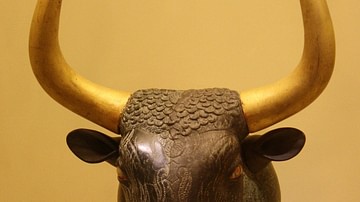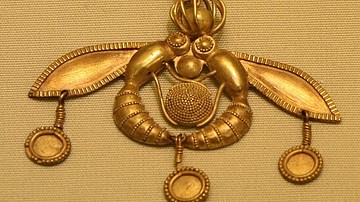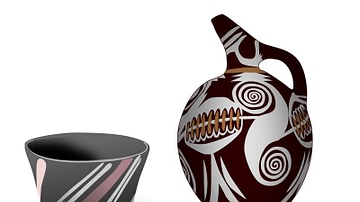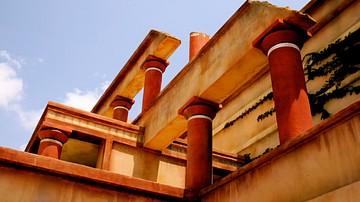Frescoes are the source of some of the most striking imagery handed down to us from the Minoan civilization of Bronze Age Crete (2000-1500 BCE). Further, without written records, they are often the only source, along with decorated pottery, of just how the world appeared to the Minoans and give us tantalizing glimpses of their beliefs, cultural practices and aesthetic tastes.
Techniques & Colours
Inherent problems with frescoes are their fragility, incompleteness and artistic anonymity. In addition, in archaeological sites they are often found removed from their original settings, making them extremely difficult to date. Perhaps, restoration has at times been over-imaginative but nevertheless, the overwhelming impression given by this art form is the Minoan's sheer joy in fluid, naturalistic and graceful forms represented in an impressionistic manner. There are also many surviving fresco fragments dating from the second phase palaces of 1550 to 1450 BCE, when the Mycenaeans began to take over the Minoan sites. However, as these are stylistically very similar to earlier Minoan frescoes, they are discussed as one in the following remarks.
As a technique, true fresco painting (buon fresco) is the painting of colour pigments on wet lime plaster without a binding agent and when the paint is absorbed by the plaster it is fixed and protected from fading. That the Minoans employed such a technique in their buildings is evidenced by string impressions in the plaster and by the depth of the paint employed. Fresco secco, which is the application of paint, in particular for details, onto a dry plaster was also used throughout the palaces as was the use of low relief in the plaster to give a shallow three dimensional effect. Colours employed were black (carbonaceous shale), red (haematite), white (hydrate of lime), yellow (ochre), blue (silicate of copper), and green (blue and yellow mixed). There are no surviving examples of shading effects in Minoan frescoes, although interestingly, sometimes the colour of the background changes whilst the foreground subjects remain unchanged. Although the Egyptians did not use true fresco, some of the colour conventions of their architectural painting were adopted by the Minoans. Male skin is usually red, female is white, and for metals: gold is yellow, silver is blue and bronze is red.
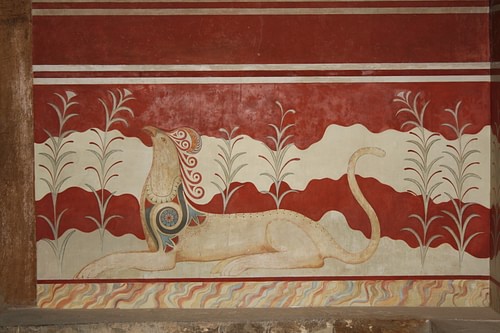
Fresco Subjects
The first examples of fresco in Crete are limited to simple monochrome walls, most often red but sometimes also black. With improvements in the quality of plaster and pigments, the advent of monumental Minoan architecture and possibly through influence from Egypt and the Near East, the technique was employed to decorate the walls (either in their entirety, above windows and doors or below the dado), ceilings, wooden beams and sometimes floors of the palace complexes, depicting first abstract shapes and geometric designs and then later, all manner of subjects ranging in size from miniature to larger than life size.
As in earlier seal and ring engravings, popular scenes for frescoes - and perhaps indicative of the role of the palaces in Minoan society - were of rituals, processions, festivals, ceremonies and bull sports. Celebrated examples include two seated priestesses on either side of a shrine, a grove of olive trees with dancers and audience, two boxers, young men in a procession carrying rhytons, and a scene of both male and female figures in various stages of bull leaping - grasping the horns or somersaulting over the back of the animal. On occasion, fresco was also used to imitate architectural features, for example, veined alabaster slabs painted on the lower portions of walls.
Natural subjects included flowers such as lilies, irises, crocuses, roses, and also plants such as ivy and reeds. Indeed, the Minoans were one of the earliest cultures to paint natural landscapes without any humans present in the scene; such was their admiration of nature.
Animals were also commonly portrayed, most often in their natural habitat, for example, monkeys, birds, cats, goats, deer, sea urchins, dolphins and fish. Although Minoan frescoes were often framed with decorative borders of geometric designs (spirals, diagonals, rosettes, and 'maze' patterns), the principal fresco itself, on occasion, went beyond conventional boundaries such as corners and covered several walls, surrounding the viewer.
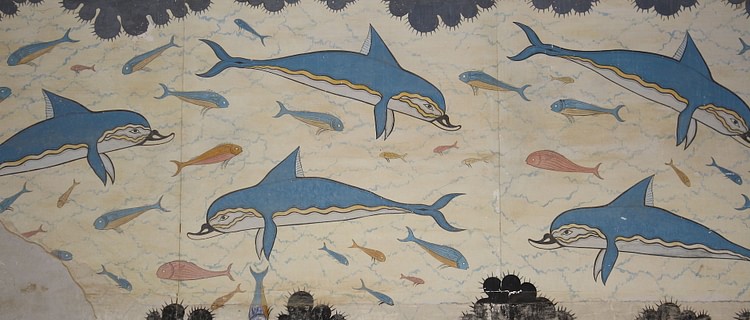
Other objects which received the fresco treatment include the celebrated limestone sarcophagus from Hagia Triada, a rare example of a fresco surviving complete. Within decorated frames, different sides of the coffin show two goddesses, each in a chariot, one drawn by goats and the other by griffins, a scene of a bull sacrifice and a funeral scene.
Legacy
The Minoan style in frescoes was influential both with contemporary cultures such as in the Cyclades (e.g. Akrotiri on Thera, Phylakopi on Melos and Hagia Irini on Keos) and with later cultures, especially the Mycenaean, albeit with slightly different subject matter such as shields and other martial paraphernalia and perhaps with a lesser importance given to naturalism. Indeed, as far afield as Tel el Dab'a in Egypt, frescoes have been discovered which are notable for their similarity in style to the Minoan.
